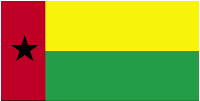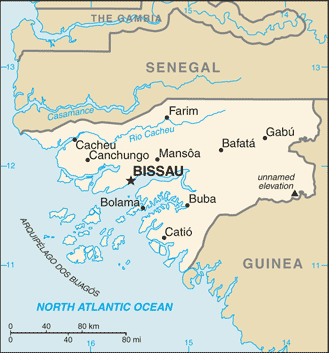Topics Covered
Welcome to Guinea-Bissau
Overview of Resources
Industrial Minerals
Metals
Investment
Sources
Welcome to Guinea-Bissau
Guinea-Bissau, with a total population of 1,628,603 as of July 2012, is located in Western Africa, bordering the North Atlantic Ocean, between Guinea and Senegal. The country mostly has a tropical climate and covers a total area of 36,125 km2.
 |
The national flag of Guinea-Bissau.
Image Credit: CIA Factbook. |
Guinea-Bissau gained its independence from Portugal in 1974 and since then the country has experienced political unrest. Farming and fishing are the main sources of income, with mining in the country being of little importance to the country’s economy.
In 2003, the country obtained financial aid from the IMF, World Bank and UNDP. Even in 2010, the World Bank and IMF decided to provide financial aid and with this financial help Guinea-Bissau experienced a progress in its economic growth rate in 2011. The country’s GDP as of 2011 was $1.95 billion.
Overview of Resources
Guinea-Bissau’s key natural resources include phosphates, granite, clay, bauxite, unexploited deposits of petroleum and limestone.
In 2010, the mineral production in the country was restrained to small-scale production of granite, sand and gravel, clay and limestone. Gold, bauxite, phosphate rock, diamond and heavy minerals were the country’s most prospective mineral resources in 2010. The country’s petroleum needs were met by imports as petroleum was not produced in Guinea-Bissau.

The map of Guinea-Bissau. Image Credit: CIA Factbook
Industrial Minerals
As the mineral industry played a small role in Guinea-Bissau, the chief mining activity that took place in 2010 dealt with the Farim phosphate project.
The Farim phosphate project has been considered as a superior quality development phosphate project that will be capable of producing about 2 million t per annum of phosphate rock in 2014. Canada’s Plains Creek Phosphate Corp. was keen on proceeding with this project in 2010.
A 100% interest in the Farim phosphate project was owned by GBMinerals AG of Switzerland. Plains Creek Phosphate Corp. entered into an agreement with GBMinerals according to which 100% interest of GBMinerals AG will be owned by Plains Creek Phosphate Corp.
Metals
In 2010, Bauxite Angola S.A. continued with its execution of the bauxite project in the Boe region. Bauxite reserves in this site amounted to about 113 Mt in 2010. Construction of a road between the mine and the port facilities and construction a deepwater port in Buba were part of the company’s plan in 2010.
Investment
Recent mining reports on foreign investments highlight the development of a US$500 million bauxite project in Guinea-Bissau by an Angolan company. This company also plans to develop reserves in Guinea-Bissau that will contain 44% aluminum oxide.
Besides this big investment, the country hopes to attract more foreign investments and expand its mining and mineral sectors. Being one of the poorest countries in the world, the country’s economic future largely depends on the proper execution of its bauxite and phosphate mining projects. With these projects in line and with more international help the country hopes to see an improvement in its economic status in the coming years.
Disclaimer: The Author of this article does not imply any investment recommendation and some content is speculative in nature. The Author is not affiliated in any way with any companies mentioned and all statistical information is publically available.
Sources
Disclaimer: The views expressed here are those of the author expressed in their private capacity and do not necessarily represent the views of AZoM.com Limited T/A AZoNetwork the owner and operator of this website. This disclaimer forms part of the Terms and conditions of use of this website.